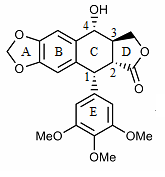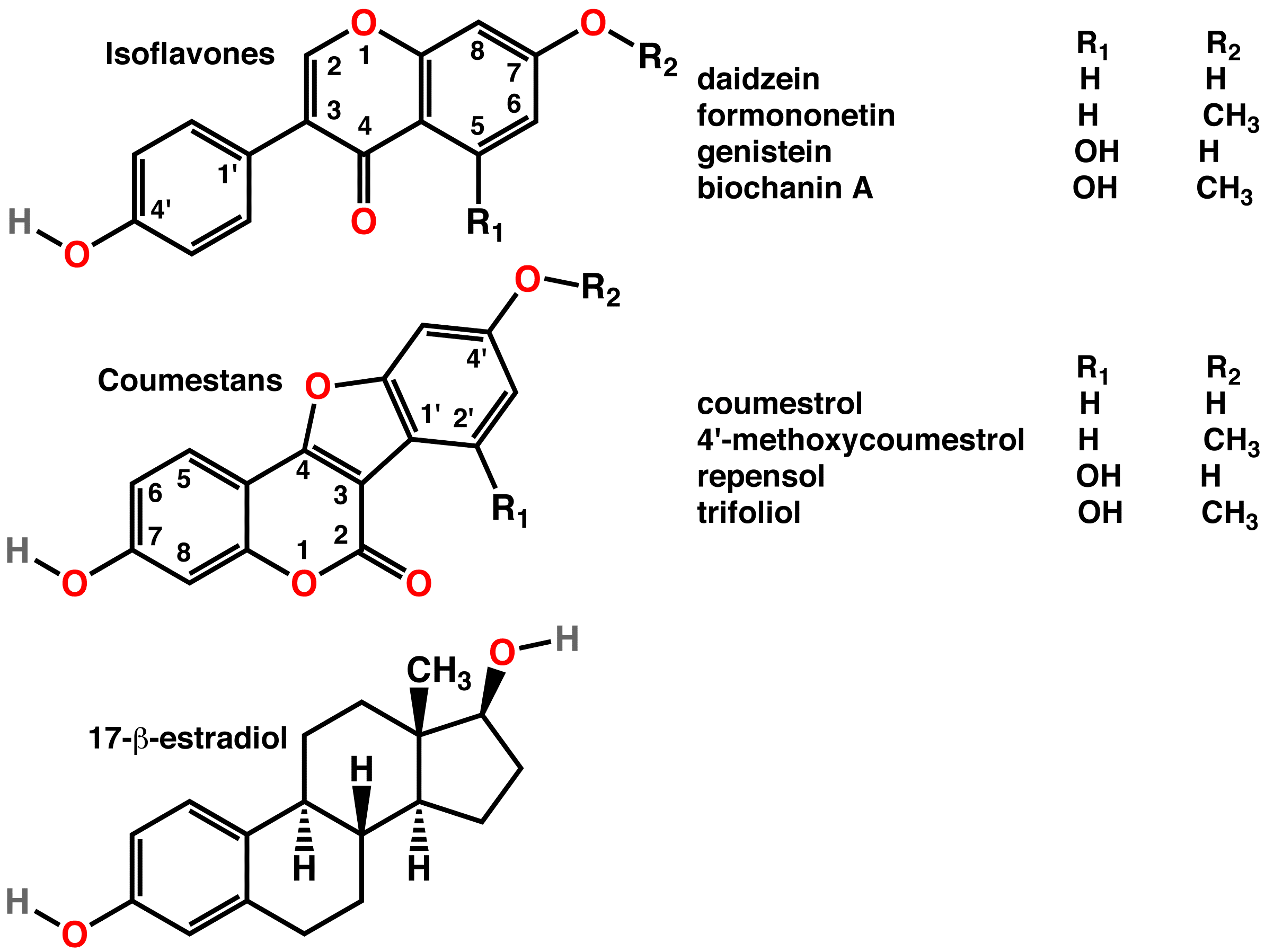|
Lignan
The lignans are a large group of low molecular weight polyphenols found in plants, particularly seeds, whole grains, and vegetables. The name derives from the Latin word for "wood". Lignans are precursors to phytoestrogens. They may play a role as antifeedants in the defense of seeds and plants against herbivores. Biosynthesis and metabolism Lignans and lignin differ in their molecular weight, the former being small and soluble in water, the latter being high polymers that are undigestable. Both are polyphenolic substances derived by oxidative coupling of monolignols. Thus, most lignans feature a C18 cores, resulting from the dimerization of C9 precursors. The coupling of the lignols occurs at C8. Eight classes of lignans are: "furofuran, furan, dibenzylbutane, dibenzylbutyrolactone, aryltetralin, arylnaphthalene, dibenzocyclooctadiene, and dibenzylbutyrolactol." Many lignans are metabolized by mammalian gut microflora, producing so-called enterolignans. Food sources Fl ... [...More Info...] [...Related Items...] OR: [Wikipedia] [Google] [Baidu] |
Enterolignan
Enterolignans are organic compounds formed by the action of gut microflora on lignans. They are thus the products of the combined action of both plants and of the animal gut. Prominent enterolignans are enterodiol Enterodiol is an organic compound with the formula OC6H4CH2CH(CH2OH)sub>2. It is formed by the action of intestinal bacteria on lignan The lignans are a large group of low molecular weight polyphenols found in plants, particularly seeds, ... and enterolactone. Enterolignans are also called "mammalian lignans", although that term is self-contradictory since mammals do not produce lignans. Enterolignans have attracted intense attention because of their potential beneficial roles in nutrition. Elevated levels of enterodiol in urine are attributed consumption of tea and other lignan-rich foods. References Polyols Lignans 3-Hydroxyphenyl compounds {{aromatic-stub ... [...More Info...] [...Related Items...] OR: [Wikipedia] [Google] [Baidu] |
Matairesinol
Matairesinol is an organic compound. It is classified as a lignan, i.e., a type of phenylpropanoid. It is present in some cereals, such as rye, and together with secoisolariciresinol has attracted much attention for its beneficial nutritional effects. Metabolism The plant lignans are precursors of the enterolignans (mammalian lignans). A number of plant lignans are metabolized to the enterolignans ( enterodiol and enterolactone) that can potentially reduce the risk of certain cancers and cardiovascular diseases. Biomedical considerations Although some studies attribute disease preventative (cardio-protective and hormone associated cancers like breast cancer) benefits of lignans, the results are inconclusive. Matairesinol has been found to act as an agonist An agonist is a chemical that activates a Receptor (biochemistry), receptor to produce a biological response. Receptors are Cell (biology), cellular proteins whose activation causes the cell to modify what it is currently ... [...More Info...] [...Related Items...] OR: [Wikipedia] [Google] [Baidu] |
Secoisolariciresinol Diglucoside
Secoisolariciresinol diglucoside (SDG) is an antioxidant phytoestrogen present in flax, sunflower, sesame, and pumpkin seeds. In food, it can be found in commercial breads containing flaxseed. It is a precursor of mammal lignans which are produced in the colon from chemicals in foods. Extraction Secoisolariciresinol diglucoside can be isolated from de-fatted (hexane solvent extraction, extraction) flaxseed by solvent extraction, extraction of the lignan polymer precursor with a water/acetone mixture, followed by acetone removal and alkaline hydrolysis. Studies on biological effects Secoisolariciresinol diglucoside slows the growth of human breast cancer in mice. Secoisolariciresinol diglucoside may be manipulated by different CYP enzymes in Eukaryotes. Due to its inherent size of 687Da, it will not pass the Blood–brain barrier, Blood–Brain Barrier (which is somewhat limited to molecules smaller than Lipinski's rule of five, 500Da). For example, in one Histology group ... [...More Info...] [...Related Items...] OR: [Wikipedia] [Google] [Baidu] |
Pinoresinol
Pinoresinol is a tetrahydrofuran lignan found in '' Styrax sp.'', '' Forsythia suspensa, and in Forsythia koreana''. It is also found in the caterpillar of the cabbage butterfly, '' Pieris rapae'' where it serves as a defence against ants. In food, it is found in sesame seed, in '' Brassica'' vegetables and in olive oil. Pinoresinol has also been found to be toxic to larvae of the milkweed bug '' Oncopeltus fasciatus'' and of the haematophagous insect '' Rhodnius prolixus'', which is a vector of chagas disease. Currently, pinoresinol is isolated from plants with low efficiency and low yield. Biosynthesis A first dirigent protein was discovered in '' Forsythia intermedia''. This protein has been found to direct the stereoselective biosynthesis of (+)-pinoresinol from coniferyl alcohol monomers. Recently, a second, enantiocomplementary dirigent protein was identified in ''Arabidopsis thaliana'', which directs enantioselective synthesis of (-)-pinoresinol. Pharmacology Pi ... [...More Info...] [...Related Items...] OR: [Wikipedia] [Google] [Baidu] |
Secoisolariciresinol
Secoisolariciresinol is an organic compound. It is classified as a lignan, i.e., a type of phenylpropanoid. It is present in some cereals, such as rye, and together with matairesinol Matairesinol is an organic compound. It is classified as a lignan, i.e., a type of phenylpropanoid. It is present in some cereals, such as rye, and together with secoisolariciresinol has attracted much attention for its beneficial nutritional e ... has attracted much attention for its beneficial nutritional effects. Occurrence The water extract of Abies alba, silver fir wood contains more than 5% of secoisolariciresinol. It is also present in nettle brew. Its content in flaxseed (Linum usitatissimum) was found to be 0.3%, which is the highest known content in food. Biomedical aspects In the intestine the gut microflora can form secoisolariciresinol from the secoisolariciresinol diglucoside and it can then be further transformed into the enterolignan enterodiol. Epidemiological studies showed ass ... [...More Info...] [...Related Items...] OR: [Wikipedia] [Google] [Baidu] |
Podophyllotoxin
Podophyllotoxin (PPT) is the active ingredient in Podofilox, a medical cream used to treat genital warts and molluscum contagiosum. It is not recommended for HPV infections without external warts. It can be applied either by a healthcare provider or the patient themselves. Podophyllotoxin is a non-alkaloid lignan extracted from the roots and rhizomes of plants of the genus ''Podophyllum''. A less refined form known as podophyllum resin is also available, but has greater side effects. Podophyllotoxin was first isolated in pure form in 1880 by Valerian Podwyssotzki (1818 – 28 January 1892), a Polish-Russian privatdozent at the University of Dorpat (now Tartu, Estonia) and assistant at the Pharmacological Institute there. PPT is on the World Health Organization's List of Essential Medicines. Medical uses Podophyllotoxin possesses a large number of medical applications, as it inhibits replication of both cellular and viral DNA by binding necessary enzymes. It can addition ... [...More Info...] [...Related Items...] OR: [Wikipedia] [Google] [Baidu] |
Steganacin
Steganacin is an dibenzocyclooctadiene lactone, an unusual type of lignan. It exhibits some antileukemic properties ''in vitro ''In vitro'' (meaning ''in glass'', or ''in the glass'') Research, studies are performed with Cell (biology), cells or biological molecules outside their normal biological context. Colloquially called "test-tube experiments", these studies in ...''. It has been isolated from '' Steganotaenia araliacea''. (−)-Steganacin is the natural form. Notes Lignans Antineoplastic drugs Benzodioxoles Heterocyclic compounds with 5 rings Acetate esters Methoxy compounds Lactones {{aromatic-stub ... [...More Info...] [...Related Items...] OR: [Wikipedia] [Google] [Baidu] |
Soybean
The soybean, soy bean, or soya bean (''Glycine max'') is a species of legume native to East Asia, widely grown for its edible bean. Soy is a staple crop, the world's most grown legume, and an important animal feed. Soy is a key source of food, useful both for its protein and oil content. Soybean oil is widely used in cooking, as well as in industry. Traditional unfermented food uses of soybeans include edamame, as well as soy milk, from which tofu and tofu skin are made. Fermented soy foods include soy sauce, fermented bean paste, nattō, and tempeh. Fat-free (defatted) soybean meal is a significant and cheap source of protein for animal feeds and many packaged meals. For example, soybean products, such as textured vegetable protein (TVP), are ingredients in many meat and dairy substitutes. Soy based foods are traditionally associated with East Asian cuisines, and still constitute a major part of East Asian diets, but processed soy products are increasingly used ... [...More Info...] [...Related Items...] OR: [Wikipedia] [Google] [Baidu] |
Justicidin A
Justicidin A is an organic compound isolated from '' Justicia procumbens''. It is classified as a lignan. The compound may possess cytotoxic Cytotoxicity is the quality of being toxic to cells. Examples of toxic agents are toxic metals, toxic chemicals, microbe neurotoxins, radiation particles and even specific neurotransmitters when the system is out of balance. Also some types of dr ... effects. References Lactones Benzodioxoles Phenol ethers Lignans Naphthofurans Methoxy compounds {{Ether-stub ... [...More Info...] [...Related Items...] OR: [Wikipedia] [Google] [Baidu] |
Phytoestrogen
A phytoestrogen is a plant-derived xenoestrogen (a type of estrogen produced by organisms other than humans) not generated within the endocrine system, but consumed by eating plants or manufactured foods. Also called a "dietary estrogen", it is a diverse group of naturally occurring nonsteroidal plant compounds that, because of its structural similarity to estradiol (17-β-estradiol), have the ability to cause both estrogenic or antiestrogenic effects. Phytoestrogens are not essential nutrients because their absence from the diet does not cause a disease, nor are they known to participate in any normal biological function. Common foods containing phytoestrogens are soybeans and soy protein concentrate, miso, tempeh, and tofu. Some soy-based infant formulas manufactured with soy protein contain isoflavones. Its name comes from the Greek ''phyto'' ("plant") and ''estrogen'', the hormone which gives fertility to female mammals. The word "estrus" (Greek οίστρος) ... [...More Info...] [...Related Items...] OR: [Wikipedia] [Google] [Baidu] |
Polyphenol
Polyphenols () are a large family of naturally occurring phenols. They are abundant in plants and structurally diverse. Polyphenols include phenolic acids, flavonoids, tannic acid, and ellagitannin, some of which have been used historically as dyes and for tanning (leather), tanning garments. Etymology The name derives from the Ancient Greek word (, meaning "many, much") and the word ‘phenol’ which refers to a chemical structure formed by attachment of an aromatic benzenoid (phenyl) ring to a hydroxyl (-OH) group (hence the ''-ol'' suffix). The term "polyphenol" has been in use at least since 1894. Definition Polyphenols are natural products with "one or several hydroxyl groups on aromatic rings", including four principal classes: phenolic acids, flavonoids, stilbenes, and lignans. Flavonoids can be grouped as flavones, flavonols, flavanols, flavanones, isoflavones, proanthocyanidins, and anthocyanins. Particularly abundant flavanoids in foods are catechin (tea, frui ... [...More Info...] [...Related Items...] OR: [Wikipedia] [Google] [Baidu] |
Sesame Seed
Sesame (; ''Sesamum indicum'') is a plant in the genus ''Sesamum'', also called benne. Numerous wild relatives occur in Africa and a smaller number in India. It is widely naturalized in tropical regions around the world and is cultivated for its edible seeds, which grow in pods. World production in 2018 was , with Sudan, Myanmar, and India as the largest producers. Sesame seed is one of the oldest oilseed crops known, domesticated well over 3,000 years ago. ''Sesamum'' has many other species, most being wild and native to sub-Saharan Africa. ''S. indicum,'' the cultivated type, originated in India. It tolerates drought conditions well, growing where other crops fail. Sesame has one of the highest oil contents of any seed. With a rich, nutty flavor, it is a common ingredient in cuisines around the world. Like other foods, it can trigger allergic reactions in some people and is one of the nine most common allergens outlined by the Food and Drug Administration. Etymology The wo ... [...More Info...] [...Related Items...] OR: [Wikipedia] [Google] [Baidu] |

